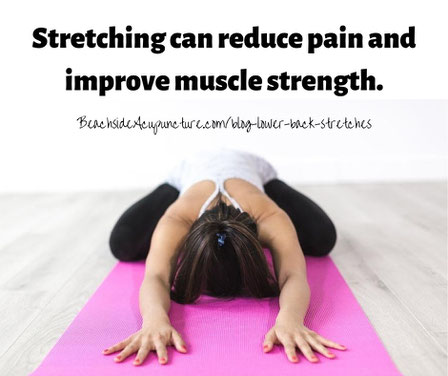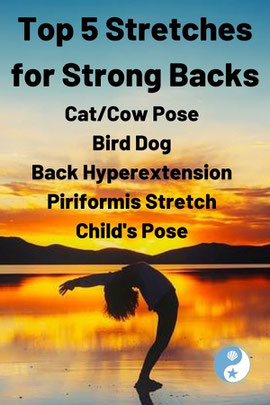
Let's be honest with one another, shall we? When your back is aching and it hurts to do anything, a day on the sofa or in bed with Netflix sounds very appealing, doesn't it? Resting your back for a day or two is fine if all you are feeling is simple overexertion, but after that, resting is doing more harm than good. While you might be enjoying that Breaking Bad marathon, the muscles that are supporting your back are becoming weaker. This means that when you do get up and get back to your normal activities, chances are that you will injure your back even more seriously than before. In fact, research shows that the best way to stop lower back pain is to do a combination of regular aerobic exercise, strength training, and a stretching program such as yoga. Is there anything you can do on your own to stop back pain and make the back stronger? You bet there is, and that's what I'm here to talk about in this article.
Why does my lower back always seem to ache or feel tight?
There are almost as many reasons for back pain as there are new pills on the market to "treat" it. The fact is that nearly everyone on the planet, with some experts estimating as many as 80% of the population, will have back pain at one time or another. One problem nearly everyone has is inflammation. While inflammation is a natural part of the body's immune system, it causes pain. Eating an anti-inflammatory diet and getting exercise is one way to beat inflammation and back pain. Perhaps the two biggest problems that lead to back pain are sitting and poor posture. Your mother always told you to sit up straight and she was right!
Sitting is the new smoking. Unfortunately, smoking is a choice and sitting is not. Many Americans find themselves at desk jobs, typing away on a computer. We do more sitting while commuting, and then at home looking at our phone, tablet, or television. One hour of exercise three times a week is not going to counteract all that sitting. To top it off, we slouch. Check out your posture the next time you are sitting in front of your computer. Your shoulders are hunched forward, your head down, your upper back rounded, and the lower back probably stuck out or sucked in. Improve your posture and you automatically improve your back. If you aren't sure how you should be sitting, you can read about it here.
How can I make my lower back stronger?
Stretching regularly and practicing good posture will help you tremendously when it comes to improving and strengthening your lower back. You should also strengthen core muscles, especially the ones that support the lower back. These would be the abdomen and pelvic floor muscles. Strengthening exercises are extremely helpful for stopping low back pain and preventing it from returning.
Can stretching also make my back stronger?
Yes, it can. Pilates, Tai Chi, and yoga have all been shown in studies to not only reduce pain but improve strength. These stretching programs increase muscle strength by holding the body in certain positions. Other mind/body exercises, such as meditation, have also been shown to have very desirable results when it comes to chronic low back pain.

Top 5 Stretches for Strong Backs
The following are five of the best stretches for reducing pain and strengthening the back. If you feel any pain when performing these stretches, try to modify the stretch or stop doing that particular stretch until your body has healed or your doctor/chiropractor tells you that it is okay for you to try again.
1. Cat/cow Pose
This easy-to-do stretch looks so simple, you wonder how it can work! This pose both stretches and strengthens the neck and spine, in addition to stretching the hips and lower abdomen.
Kneel on the floor on all fours, like a cat. Arch your back up towards the ceiling, dropping your chin to your chest. Hold for a count of five, then push your belly towards the floor and look straight ahead. Hold again for a count of five. Repeat this stretch ten times if you can.
2. Bird Dog
This pose works the spine, the glutes, and the lower abdomen. This is a good pose to help you develop better posture and balance.
Kneel on a mat on all fours, knees directly under the hips, hands flat on the floor under the shoulders. Stretch out your right leg and left arm, keeping your head neutral. Hold for a count of five, then switch legs/arms. If you can't put your leg straight out behind you, do the best you can. Repeat this five times on each side, or ten times total.
3. Back Hyperextension
The strengthening exercise with the big name! This will help to strengthen the erector spinae, which supports the lower portion of the back while working the hips, shoulders, and glutes.
Lie face down on the floor. (You may want to put a flat pillow under your hips.) Place your arms at your sides, forehead on the floor. Lift your head and arms off the floor as much as possible. Don't worry, you probably can't move them more than a few inches, and that's fine. Hold for a count of two or three, and then release. Repeat ten times.
4. Piriformis Stretch
You mustn't stretch too hard when doing this exercise. The piriformis is a small, flat muscle in the buttocks. This small but important muscle stabilizes the hips, allowing you to move your thighs away from your body. When this muscle becomes tight from too much sitting, it can cause low back pain and pain similar to sciatica.
To stretch the piriformis, sit in a chair and place your left ankle on top of your right knee. Press down on your left knee. Sit up straight and then bend at the waist. If your ankle slides off your knee, hold it in place with your hand. You will really feel this stretch in the behind, so don't stretch too hard or you will be very sore the next day. Hold the stretch for 30 seconds, and then repeat with the opposite leg. Just once per day will keep this muscle long and flexible.
5. Child's Pose
This stretch feels so good!
Sit back on your heels, knees spread apart. Put your arms on the floor in front of you and gently bend at the waist, falling forward as much as possible. You can use your hands and finger to pull and stretch yourself a bit if it doesn't hurt. Take a deep breath in, and then out, and then return to start. You can do this stretch as often as you'd like!

My back still hurts. What should I do?
If it feels as though you've tried everything and your back is still bothering you, it might be time to see a professional. Despite our best efforts, our bodies sometimes develop more serious problems that cause back pain, including spinal stenosis, disc degeneration, and even arthritis. While some of these health problems can't be cured, the pain can be managed. Seeing a healthcare professional, such as your primary care physician or chiropractor, will help determine the root cause of the pain.
Chiropractors are experts in all things musculoskeletal, so they can not only help to determine the cause of your pain but how to best help the body heal or how the pain can best be managed. In addition to adjustments, a chiropractor might also suggest other lifestyle changes, such as a different form of exercise, a good detox program, or acupuncture, massage therapy, or dietary supplements to help stop inflammation.
Stay strong and flexible and eat a healthy diet for a strong back that should last you a lifetime!
Dr. Brent Wells, D.C., founded Better Health Chiropractic & Physical Rehab and has been a chiropractor for over 20 years. His practice has treated thousands of Alaskan patients with physical therapy, chiropractic care, and massage therapy designed to help give long-lasting relief. Dr. Wells is also the author of over 700 online health articles that have been featured on sites such as Dr. Axe, Organic Facts, and Thrive Global. He is a proud member of the American Chiropractic Association and the American Academy of Spine Physicians. He continues his education to remain active and updated in all studies related to neurology, physical rehab, biomechanics, spine conditions, brain injury trauma, and more.









